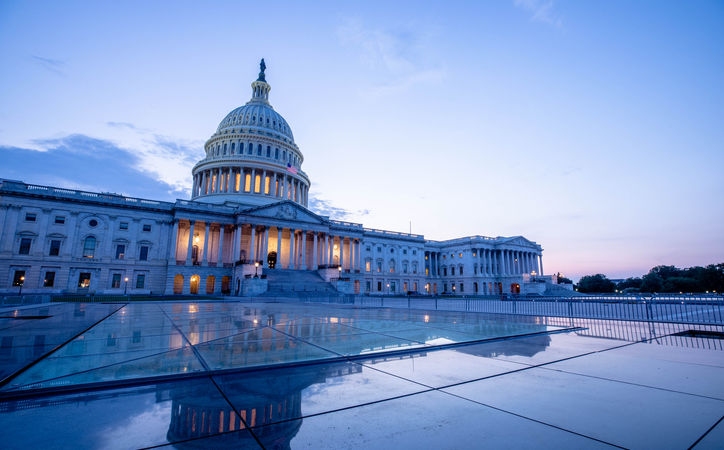On March 10, 2021, the House passed the Senate amendments to the American Rescue Plan Act of 2021 (ARPA, HR 1319). The Senate had passed the bill on Saturday, March 6, 2021. The Congress-passed legislation now goes to President Biden, who is expected to sign the bill into law by Friday, March 12, 2021.
Background
The American Rescue Plan Act of 2021 (ARPA) extends and expands provisions found in the Families First Coronavirus Relief Act (FFCRA), Coronavirus Aid, Relief and Economic Security (CARES) Act, and the Consolidated Appropriations Act, 2021 (CAA, 2021).
Paid Sick and Family Leave Credits
Changes under ARPA apply to amounts paid with respect to calendar quarters beginning after March 31, 2021. ARPA, 2021:
- Extends the FFCRA paid sick time and paid family leave credits from March 31, 2021 through September 30, 2021.
- Provides that paid sick and paid family leave credits may each be increased by the employer’s share of Social Security tax (6.2%) and employer’s share of Medicare tax (1.45%) on qualified leave wages.
- Permits the Treasury Secretary to waive for failure to deposit penalties on “applicable employment taxes” if the failure to deposit is due to an anticipated credit. “Applicable employment taxes” are defined as the employer’s share of Medicare or Tier 1 RRTA tax.
- Allows for the credits for paid sick and family leave to be structured as a refundable payroll tax credit against Medicare tax only (1.45%), beginning after March 31, 2021.
- Increases the amount of wages for which an employer may claim the paid family leave credit in a year from $10,000 to $12,000 per employee.
- Expands the paid family leave credit to allow employers to claim the credit for leave provided for the reasons included under the previous employer mandate for paid sick time. For the self-employed, the number of days for which self-employed individuals can claim the paid family leave credit is increased from 50 to 60 days.
- Permits the paid sick and family leave credit to be claimed by employers who provide paid time off for employees to obtain the COVID-19 vaccination or recover from an illness related to the immunization.
- Increases the paid sick and family leave credit by the cost of the employer’s qualified health plan expenses and by the employer’s collectively bargains contributions to a defined benefit pension plan and the amount of collectively bargained apprenticeship program contributions.
- Establishes a non-discrimination requirement where no credit will be permitted to any employer who discriminates in favor of highly compensated employees as defined under Code Sec. 414(q), full-time employees, or employees on the basis of employment tenure.
- Resets the 10-day limitation on the maximum number of days for which an employer can claim the paid sick leave credit with respect to wages paid to an employee. The current 10-day limitation runs from the start of the credits in 2020 through March 31, 2021. For the self-employed, the 10-day reset applies to sick days after January 1, 2021 for self-employed individuals.
- Clarifies that while no credit for paid sick and family leave may be claimed by the federal government or any federal agency or instrumentality, this would not apply to any organization described under Code Sec. 501(c)(1) and exempt from tax under Code Sec. 501(a) , including state and local governments.
Employee Retention Credit
The new legislation:
- Extends the ERC from June 30, 2021 until December 31, 2021. The legislation would continue the ERC rate of credit at 70% for this extended period of time. It also continues to allow for up to $10,000 in qualified wages for any calendar quarter. Considering the CAA extension and the pending ARPA extension, this means an employer would potentially have up to $40,000 in qualified wages per employee through 2021.
- Limits the ERC to $50,000 per calendar quarter of an eligible employer that is a “recovery startup business.” A “recovery startup business” is one that: (1) began operations after February 15, 2020 whose average annual gross receipts for a 3-taxable-year period ending with the taxable year which precedes such quarter does not exceed $1,000,000, and (2) experiences a full or partial suspension of operations due to a governmental order or experiences a significant gross receipts decline.
- Allows the credit to be claimed against Medicare (1.45%, Hospital Insurance – HI) taxes only. Since the employer/employee tax rate for Medicare is 1.45%, it could take longer to immediately claim the credit under the ARPA for the third and fourth quarters of 2021. Instead of just withholding the taxes immediately, it could be more likely that more employers would need to file Form 7200 (Advance Payment of Employer Credits Due to COVID-19).
- Continues the year-over-year gross receipts decline requirement at 20%; and the threshold for qualified wages (even if the employee is working) would continue to be 500 employees, as expanded by the CAA. Also, certain governmental employers would continue to be exempt from claiming the ERC, except certain tax-exempt organizations that would include colleges and universities or medical or hospital care providers.
- Requires the Treasury Secretary to issue guidance providing that payroll costs paid during the covered period would not fail to be treated as qualified wages to the extent that a covered loan under the Small Business Act is not forgiven. As with the expansion of the ERC under the CAA, this would continue to mean that Paycheck Protection Program (PPP) recipients would be eligible if the loan did not pay the wages in question.
- Qualified wages paid by an employer taken account as payroll costs under (1) Second Draw PPP loans; (2) shuttered venues assistance and (3) restaurant revitalization grants are not eligible for the ERC.
Unemployment Provisions
The new legislation:
- Extends continued unemployment provisions to September 6, 2021. This would include the: (1) pandemic unemployment assistance (PUA), (2) federal pandemic unemployment compensation (FPUC), (3) pandemic emergency unemployment compensation (PEUC), (4) the funding for waiving the one-week unemployment benefit waiting period, (5) the temporary financing of short-time compensation (STC) payments for states with programs, (6) STC agreements for states without programs, (7) temporary assistance for states with federal unemployment advances, and (8) the full federal funding of extended unemployment compensation.
- Observation: Further temporary suspension on the accrual of interest on federal unemployment loans to states and a waiver of interest payments under the ARPA assists certain employers that otherwise would have to pay an unemployment tax assessment.
- Extends the FPUC unemployment payment of $300 per week through September 6, 2021.
- Does not extend the 50% credit for reimbursing employers.
Paycheck Protection Program Modifications
The new legislation:
- Allocates an additional $7.25 billion towards PPP funding, however, the application period has not been extended and remains March 31, 2021.
- Adds “additional covered nonprofit entity” as an eligible nonprofit eligible for First Draw and Second Draw PPP loans. An “additional covered nonprofit entity” is an organization Code Sec. 501(c) other than those Code Sec. 501(c)(3), Code Sec. 501(c)(4), Code Sec. 501(c)(6), or Code Sec. 501(c)(19). An “additional covered nonprofit entity” is eligible for a PPP loan if: (1) the organization employs no more than 300 employees; (2) it does not receive more than 15% of its receipts from lobbying activities; (3) lobbying activities do not comprise more than 15% of the organization’s total activities; and (4) the cost of lobbying activities does not exceed $1,000,000 during the most recent tax year that ended prior to February 15, 2020.
- Adds the following to eligible entities for PPP loans: (1) Code Sec. 501(c)(3) nonprofit and veterans’ organizations with up to 500 employees; and (2) Code Sec. 501(c)(6) nonprofit organizations (business leagues, chambers of commerce, real estate boards, boards of trade and professional football leagues); and (3) domestic marketing organizations with no more than 300 employees per physical location.
- Adds Internet-only news publishing and Internet-only periodical publishers to businesses eligible for First and Second Draw PPP loans. To be eligible, the organization must employ no more than 500 employees.
- Provides that amounts used from First Draw and Second Draw PPP loans for premiums used to determine the credit for COBRA premium assistance as provided under Code. Sec. 6432 are eligible for loan forgiveness. See Pension and Benefits Related Provisions below for further information regarding COBRA.
Other Relief-Related Provisions
Restaurant revitalization grants. ARPA appropriates $28,600,000,000 for fiscal year 2021 to struggling restaurants to be administered by the SBA. The money will be available until expended. Eligible entities include restaurants, or other specified food businesses, and includes businesses operating in an airport terminal. It does not include a state or local government operated business, or a company that as of March 13, 2020 operates in more than 20 locations, whether or not the locations do businesses under the same name. It also does not include any business that has a pending application for, or has received, and grant under the Economic Aid to Hard-Hit Small Businesses, Non-Profits and Venues Act. The amount given to any business who fulfills the eligibility and certification requirements is $10,000,000 and limited to $5,000,000 per physical location of the business. Grants may be used for: (1) payroll costs; (2) mortgage payments; (3) rent; (4) utilities; (5) maintenance expenses; (6) supplies; (7) food and beverage expenses; (8) covered supplier costs; (9) operational expenses; (10) paid sick leave; and (11) any other expense determined to be essential to maintaining the business.
Shuttered venue operators. CAA, 2021 authorized grants to eligible live venue operators or promoters, theatrical producers, live performing arts organization operators, museum operators, motion picture theatre operators, or talent representatives who demonstrate a 25% reduction in revenues. ARPA appropriates $1,250,000,000, for fiscal year 2021, to help carry out these grants. The money will be available until expended. Governmental entities do not qualify.
Aviation manufacturing job protection. ARPA establishes a payroll support program for the continuation of employee wages, salaries and benefits for aviation manufacturing employers who have furloughed at least 10% of its workforce in 2020 compared to 2019 or experienced a 15% decline in revenues from 2019 to 2020 (although separate qualifications are set forth for companies that had no involuntary furloughs.
Additional relief provisions. ARPA establishes funds to assist the National Railroad Passenger Association and airports financially impacted by COVID-19.
Earned Income Credit
For tax years beginning after December 31, 2020, and before January 1, 2022, for taxpayers with no qualifying children:
- The 7.65% credit percentage and phaseout percentage is increased to 15.3%.
- The $4,220 earned income amount is increased to $9,820.
- The $5,280 phaseout amount is increased to $11,610. These amounts are not adjusted for inflation.
- Observation: ARPA does not mention any change to the $5,000 amount for married taxpayers. Presumably, then, the phaseout amount for married taxpayers is $16,610 (using the unadjusted $5,000 amount).
Pension and Benefits Related Provisions
Dependent Care Assistance. The amount of taxable wage exclusion for dependent care benefits is increased from $5,000 to $10,500 for married couples filing jointly. The amount of excludable wages for married couples filing separately is $5,250. This increase applies to any taxable year beginning after December 31, 2020, and before January 1, 2022, effective December 31, 2020.
COBRA. Under ARPA, Assistance Eligible Individuals (AEIs) may receive an 85% subsidy for COBRA premiums paid during any period of COBRA coverage during the period beginning on April 1, 2021 (the first day of the first month beginning after enactment) and ending on September 30, 2021.
- Refundable tax credit. Employers will be allowed a quarterly tax credit against the Medicare payroll tax equal to the premium amounts not paid by AEIs. If the credit amount exceeds the quarterly Medicare payroll tax, the excess will be treated as an overpayment refundable under and Code Sec. 6402(a) and Code Sec. 6413(b). The quarterly credit may be paid in advance according to forms and instructions to be provided by the Department of Labor.
- Notice requirements. Group health plans must provide the following notices to AEIs:
- Notice of assistance availability. Informs AEIs of the availability of the subsidy and the option to enroll in different coverage (if permitted by the employer). Must be provided to individuals who become eligible to elect COBRA during the period beginning on April 1, 2021 and ending on September 30, 2021. This notice requirement may be met by amending existing notices or including a separate document along with them. Specific content requirements apply.
- Notice of extended election period. Must be provided to individuals eligible for an extended election period within 60 days after April 1, 2021.
- Notice of expiration of subsidy. Must be provided between 45 and 15 days before the date on which an individual’s subsidy will expire, unless the subsidy is expiring because the individual has gained eligibility for coverage under another group health plan or Medicare.
Provision of these notices is required to meet COBRA’s notice requirements.
- Model notices. Within 30 days of enactment, the Department of Labor is to issue model notices which can be used to notify eligible individuals of the availability of assistance and the availability of an extended enrollment period. Within 45 days, the Department is to issue model notices regarding the expiration of the subsidy.








